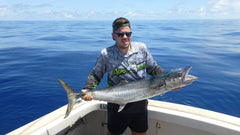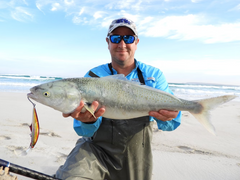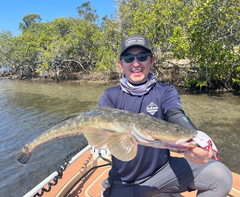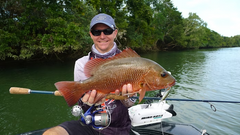
Barramundi are an enigmatic and exciting target wherever you find them, and the extra-oversized models found in our impoundments are no exception. Anyone who wants to nail their first metre-plus barra would be mad not to consider one of the many dams scattered across the top half of the country. These fish are big, challenging, and they go absolutely crazy on the end of a line.
Make no mistake, despite living in a big ditch, these fish present a huge learning curve, and even though they don’t have to deal with the rigours of the wild, they are a very tough adversary; both figuratively and physically! Delve into the impoundment scene though and you’ll soon discover that landing big barra consistently isn’t just for locals who fish for them all the time, but there are a few little things to understand about impoundment barra if you want tip the odds in your favour.
Wild vs Stocked Barra
Barramundi in dams are stocked, which means they have been put in there specifically for angling. Barramundi cannot breed in still freshwater, so stocking needs to be ongoing for a dam to maintain a population.
Wild fish live in estuaries, along coasts or in natural bodies of freshwater like billabongs and oxbow lakes, so their supply of food is dependent on environmental conditions and will fluctuate. Dam fish on the other hand usually have a consistent oversupply of forage such as bony bream, crayfish, garfish, barred grunter and even recently stocked barramundi fingerlings! Because of this, dam fish can pile on the pounds very quickly, sometimes reaching a metre long and over 20kg in just four years!

Seasonal Habits
Impoundment barra will move about a dam to seek one of two things, food or comfort. If they aren’t capitalising on a feeding opportunity, they’ll be hanging out somewhere comfortable, not moving very much, and recharging for their next feeding opportunity.
Summer in the tropics is generally extremely hot or pouring with rain—sometimes both! In times of severe heat over 30°C (with surface water over 27°C), barra will tend to seek deeper water where it's cooler. At night, they may move shallow to feed, or they may stay out deeper if it’s still too warm in the shallows.
Following big bouts of rain, barra often seek out areas where water is flowing into the dam. In these areas, they can soak in cool, oxygen-rich water. All barramundi tend to seek out flowing water instinctively, as these areas often provide an inflow of food.

As it starts to cool through autumn and into winter, the barra will begin searching for warmer water. Sun-warmed shallow bays and banks tend to be their favourite areas, especially if the wind is blowing slightly warmer surface water into them.

Fishing for Dam Barra
Finding barra is key to catching them, and an understanding of their seasonal movements is a good start. However, barra aren’t always predictable. A good fish finder with side imaging and/or 360 live imaging is highly recommended for locating fish.

Dam Barra Tackle
Barramundi will regularly grow to colossal sizes in dams, so it’s essential to fish with adequate tackle. Spin and baitcast outfits in a medium-heavy rating (approximately 4-8kg) are the minimum standard, with braided lines between 30-80lb and leaders between 50-80lb depending on the size of the fish and terrain.

Recommended Lures for Barra
Impoundment barra will eat most things, and anything between 100-250mm is considered a good snack size. A few favourites include the Lucky Craft Pointer 100XD, Zerek Fish Trap in 95 and 110mm, and the Rapala Skitter V 13. The trick is to cover your bases from the top of the water column to the bottom and be prepared to try various lures.
Make the Trip
The only way you’re going to crack the dam barra code is by getting out to a dam and giving it a go! Many impoundments hold barra, including Lake Tinaroo, Lake Proserpine, Teemburra Dam, Kinchant Dam, and more.

Once the impoundment barra bug bites, it’s hard to shake off! Good luck, and tight lines.
Article by Bob Thornton

 Select Store
Select Store








